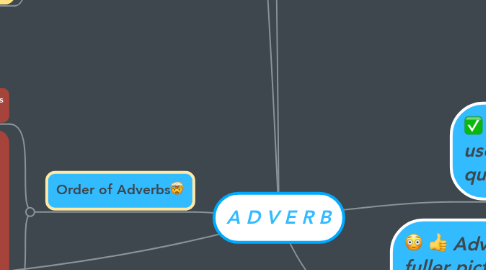
1. Thankfully, there is a simple set of rules to follow, called the order of adverbs. Handily, the order of adverbs, sometimes also called the royal order of adverbs, can help us determine sentence structure too. In short, the adverbs get preference (are placed first) in the following order:😏
1.1. Adverbs of manner. Adverbs of place. Adverbs of frequency. Adverbs of time. Adverbs of purpose.
2. adverbs provide a description of how, where, when, in what manner and to what extent something is done or happens.
2.1. Adverbs can always be used to modify verbs.
2.2. An adverb can be used to modify an adjective and intensify the meaning it conveys.
2.2.1. For example :
2.2.1.1. He plays tennis well. (He knows how to play tennis and sometimes he wins.)
2.2.1.1.1. He plays tennis extremely well. (He knows how to play tennis so well that he wins often.)
3. Types of Adverbs😳👍🏿
3.1. Adverbs of Manner
3.1.1. An adverb of manner will explain how an action is carried out. Very often adverbs of manner are adjectives with -ly added to the end, but this is certainly not always the case.
3.1.1.1. For example :
3.1.1.1.1. Slowly Rapidly Clumsily Badly
3.1.1.1.2. She passed the exam easily. They walk quickly to catch the train.
3.2. Adverbs of place
3.2.1. An adverb of place, sometimes called spatial adverbs, will help explain where an action happens.
3.2.1.1. For example:
3.2.1.1.1. There was a deli Jane is moving far away. Carly is sitting close to me.
3.2.1.2. For example:
3.3. Adverbs of Frequency
3.3.1. Adverbs of frequency are used to express time or how often something occurs.
3.3.1.1. For example :
3.3.1.1.1. The adverb is usually placed before the main verb. I can normally make the shot. I will always love
3.3.1.1.2. For example :
3.4. Adverbs of Time
3.4.1. Adverbs of time, while seemingly similar to adverbs of frequency, tell us when something happens.
3.5. Adverbs of Purpose
3.5.1. Adverbs of purpose, sometimes called adverbs of reason, help to describe why something happened. They can come in the form of individual words – so, since, thus, because – but also clauses – so that, in order to.
3.5.1.1. For example :
3.5.1.1.1. I started jogging so that I wouldn’t be late. Because I was late, I jogged a little faster.
3.6. Positions of Adverbs
3.6.1. The positions of adverbs are not a fixed or set thing. As you have seen, adverbs can appear in different position in a sentence.
3.6.1.1. For example :
3.6.1.1.1. She laughed timidly. I stroked the cat gently.
4. Order of Adverbs🤯
4.1. Adverb order is so important it has clear rules.
4.2. but how do you decide the structure of a sentence with several adverbs?🤯🤯🤯🤯🤯🤯
5. An adverb is a word that is used to change, modify or qualify several types of words
5.1. including an🤨
5.1.1. Adjective
5.1.2. Verb
5.1.3. A clause
5.1.4. And another adverb
5.1.5. or any other type of word or phrase, with the exception of determiners and adjectives.
